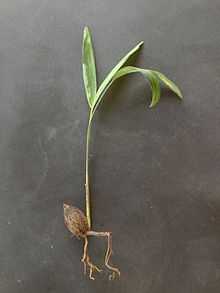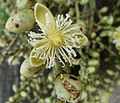Wodyetia
| Wodyetia | |
|---|---|
 | |
| Wodyetia bifurcata | |
| Conservation status | |
| Scientific classification | |
| Kingdom: | Plantae |
| (unranked): | Angiosperms |
| (unranked): | Monocots |
| (unranked): | Commelinids |
| Order: | Arecales |
| Family: | Arecaceae |
| Genus: | Wodyetia A.K.Irvine |
| Species: | W. bifurcata |
| Binomial name | |
| Wodyetia bifurcata A.K.Irvine | |
The Foxtail Palm (Wodyetia bifurcata) is a species of flowering plant in the Arecaceae family[1]
The Palm and Cycads Societies of Australia (PACSOA) describes this Palm as follows:
"Very attractive palm with long (2-3m.) plumose leaves (hence the name 'Foxtail'), and up to 10m tall with a grey trunk. It produces large (about the size of a duck egg) orange fruit"[2]
Etymology
Most of the world was unaware of the existence of this 'spectacular' palm until 1978, when an Aboriginal man brought it to botanists and the world's attention[3]
The Aboriginal name of that Aboriginal man has been recorded as being "Wodyeti", thus the genus name for this Australian endemic species Wodyetia. The specific name "bifurcata" is from Latin meaning “twice divided,” in reference to its leaves.
Ecology and habitat
The Foxtail Palm is endemic to a very small part of Australia, originally decorating the boulder strewn, exposed gravel hills of the Cape Melville range, wholly within the Cape Melville National Park.[2]
The area has been recognised for its rich biocultural diversity, having long and intense Aboriginal associations and a rich biodiversity.[4]
In addition to being a habitat for Foxtail Palms, the Melville Range is a habitat for animals such as the Godman's rock-wallaby (Petrogale godmani), the tropical ring-tailed gecko (Cyrtodactylus louisiadensi) plus endemic frogs and lizards such as the Cape Melville boulder skink (Cryptoblepharus fuhni), the Melville Range treefrog (Litoria andiirrmalin) and the Cape Melville boulderfrog (Cophixalus zweifeli).[4]
Physical attributes

Flowering: White flowers stalk that comes from the base of the crownshaft.[5]
Foliage: Variance of greenish colors; deep green to light green colors. Received its more commonly known Australian-English name from the appearance of its foliage, which is in a shape of a fox’s tail.[5]
Fruits: 2 inches long. Olive green to green in the early stages. Orange red when ripe.[5]
Trunk: Similar to the king palm, the foxtail palm trunk is smooth, thin, and self-cleaning. It grows a single, double, or triple trunk that is slightly spindle-shaped to columnar reaching heights of about 30 ft. The trunk also has a closely ringed, dark grey to light gray color which slowly turns more and more white. The crownshaft of the foxtail palm is light to bright green and slightly swollen at the base.[5]


Distribution
This species is endemic to the Cape Melville range, within the Cape Melville National Park in Queensland Australia. It was described in 1978, and was classed as a rare palm, both within Queensland, and on the IUCN's Red List of Threatened Species.[2]
After it became known to the world, the Foxtail Palm's seeds were so highly sought after that a thriving black market trade formed, with illegal collectors nearly decimating the in situ populations. The species propagates readily in cultivation and this ultimately reduced the pressure on the wild population. It has become widely distributed across the world, being progressively planted out as one of the "world's most popular" palms.[2][3]
-

Closeup of bark.
-

Closeup of flower.
References
- ↑ Dowl, J.L. 1998. Wodyetia bifurcata. 2006 IUCN Red List of Threatened Species. Downloaded on 20 July 2007.
- ↑ 2.0 2.1 2.2 2.3 Palm and Cycad Societies of Australia webpage on Wodyetia bifurcata Accessed 3 May 2008
- ↑ 3.0 3.1 usbg.gov plant-collections Accessed 3 May 2008
- ↑ 4.0 4.1 Queensland National Parks and Wildlife Service's (2008) Cape Melville National Park - Nature, culture and history webpage Accessed 4 May 2008 Archived April 15, 2008 at the Wayback Machine
- ↑ 5.0 5.1 5.2 5.3 "Real Palm Trees". Palm Tree Physical Appearance (Trunk and Foliage).
